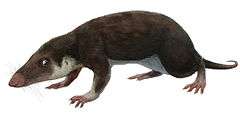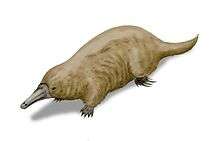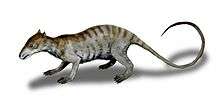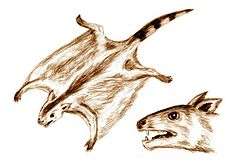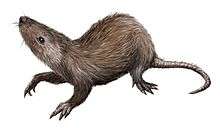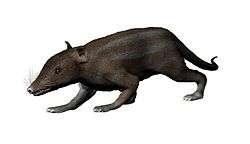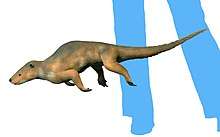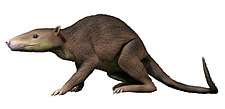Hahnodontidae
Hahnodontidae is a family of extinct mammals from Early Cretaceous deposits in Morocco and the Western US. Although originally considered to belong to the extinct clade Multituberculata, recent work indicates that hahnodontids belong to the more primitive clade Haramiyida.
| Hahnodontidae | |
|---|---|
| Scientific classification | |
| Kingdom: | Animalia |
| Phylum: | Chordata |
| Class: | Mammalia |
| Order: | †Haramiyida |
| Family: | †Hahnodontidae Sigogneau-Russell, 1991 |
| Genera | |
| |
Distribution
The genera Hahnodon and Denisodon occur in the Early Cretaceous of Morocco, while the genus Cifelliodon is found in the Barremian-age Yellow Cat Member of the Cedar Mountain Formation in Utah.[1][2][3]
Phylogeny
Sigogneau-Russell (1991) and Hahn & Hahn (2003) classified hahnodontids as multituberculates, but the cladistic analysis of Cifelliodon recovered them outside Multituberculata as phylogenetically intermediate between Docodonta and crown Mammalia. The gondwanathere Vintana was also recovered as sister to members of Hahnodontidae.[3]
References
- S. Anantharaman, G. P. Wilson, D. C. Das Sarma and W. A. Clemens. 2006. A possible Late Cretaceous "haramiyidan" from India. Journal of Vertebrate Paleontology 26(2):488-490
- G. Hahn and R. Hahn. 2003. New multituberculate teeth from the Early Cretaceous of Morocco. Acta Palaeontologica Polonica 48(3):349-356.
- Adam K. Huttenlocker; David M. Grossnickle; James I. Kirkland; Julia A. Schultz; Zhe-Xi Luo (2018). "Late-surviving stem mammal links the lowermost Cretaceous of North America and Gondwana". Nature. in press. doi:10.1038/s41586-018-0126-y.
- Sigogneau-Russell (1991), "First evidence of Multituberculata (Mammalia) in the Mesozoic of Africa". Neues Jahrb Geol Paläontol, Monatshefte, p. 119-125.
- Kielan-Jaworowska Z & Hurum JH (2001), "Phylogeny and Systematics of multituberculate mammals". Paleontology 44, p. 389-429.
- Much of this information has been derived from MESOZOIC MAMMALS: Basal Multituberculata, an Internet directory.
